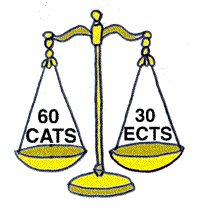Home / Course Selection
KNOW BEFORE YOU GO: Understanding the European Credit Transfer System -
Translations!
 You
may all be going to different countries with different education systems, but
fortunately there is one common European language – ECTS – which
makes the course selection process comprehensible across cultures. As ECTS is
different to what you are used to, take a minute to learn the lingo before you
start researching your courses.
You
may all be going to different countries with different education systems, but
fortunately there is one common European language – ECTS – which
makes the course selection process comprehensible across cultures. As ECTS is
different to what you are used to, take a minute to learn the lingo before you
start researching your courses.
ECTS (European Credit Transfer System) enables students taking
part in the Erasmus exchange programme to easily translate the differences between
their home and host university’s credit systems. ECTS works on the basis
of equivalents. European university courses will have an ECTS value as well
as an institutional credit rating. For instance, you may have noticed from your
home university’ Undergraduate Module Catalogue that courses have an ECTS
value and a CATS (Credit Accumulation Transfer System) value.
This means that instead of getting to grips with your Partner
University’s individual credit system, you simply need to understand the
principles of ECTS in order to understand how courses offered at your host instituion
equate to those offered at home.
 REMEMBER:
When looking at course listings, always make sure you look at the ECTS information,
rather than your Partner University’s credit system.
REMEMBER:
When looking at course listings, always make sure you look at the ECTS information,
rather than your Partner University’s credit system.
How Many ECTS Should You Take?
 ECTS is a credit
system that is based on workload – not contact hours. At UK universities
a full-time workload is 60 CATS per semester or 120 CATS per year. The equivalent
in ECTS is 30 ECTS per semester or 60 ECTS per academic year. So, 2 CATS is
equal to 1 ECTS. Don’t think that you’re getting it easy in Europe
though – it’s not half the workload!
ECTS is a credit
system that is based on workload – not contact hours. At UK universities
a full-time workload is 60 CATS per semester or 120 CATS per year. The equivalent
in ECTS is 30 ECTS per semester or 60 ECTS per academic year. So, 2 CATS is
equal to 1 ECTS. Don’t think that you’re getting it easy in Europe
though – it’s not half the workload!
All students going to Europe will need to take 30 ECTS during their semester
abroad. Single honours students should take 30 ECTS in their principal subject.
The situation is slightly more complicated for dual honours students who should
aim to take 15 ECTS in each of their degree subjects.
At Partner Universities that offer a range of courses worth 7.5 ECTS, dual
honours students should take two courses in each of their subjects. At Partner
Universities offering courses worth 15 ECTS, dual honours students should
take one course in each of their subjects.
At Partner Universities that offer mostly 6 ECTS courses, dual honours students
may find it difficult to take exactly 15 ECTS credits in each subject. In
this situation, you may have to take 12 ECTS (2 courses) in one of your subjects
and 18 ECTS (3 courses) in the other. If you need to do this, you must first
obtain the consent of your Academic Adviser.
Structural Differences
At most European universities courses run in the same way as they do here
– i.e. you will take all of your modules simultaneously over the course
of the semester. But, in Sweden things are rather different.
Click flag to find out more 
Understanding European Grading Systems
The Grade Conversion table below gives you an indication of what European
grades mean in British terms. However, this is only a guide and should be
treated as such.
| Common
ERASMUS Grading (%) |
ECTS
Grades |
ECTS
Definitions |
Austrian
Grading |
Belgian
Grading out of 20 |
Danish
Grading |
Dutch
Grading |
English
Grading |
Icelandic
Grading |
Irish
Grading |
Finnish
Grading |
French
Grading out of 20 |
German
Grading
|
Norwegian
Grading |
Spanish
Grading |
Swedish
Grading |
Swiss
Grading |
Turkish
Grading |
| >70% |
A |
EXCELLENT:
outstanding performance with only minor errors |
1
sehr gut |
16>
Excellent
- grande distinction |
13 |
10
uitstekend |
A |
9.0-10.0
Honours
|
70-100%
1.1H / A |
3,
3- |
16
>
très bien |
1 |
1.0
- 2.2 |
10
sobresaliente y matricula
de honor |
VG+
VG |
6 |
AA
(90-100%)
|
|
60-69%
|
B
|
VERY
GOOD: above the average standard but with some errors
|
2
gut |
14
très bien
- distinction |
11,
10 |
9
zeer goed |
B+ |
7.25-8.99
1st
Class |
62-70%
2.1 H / A |
2,5,
2+ |
14,
15 bien |
2 |
2.3
- 2.6 |
9
sobresaliente |
G+ |
5,
5 |
BB
(80-84% |
|
50-59% |
C |
GOOD:
generally sound work with a number of notable errors |
3
befriedigend
|
13
bien |
9,
8 |
7-8
goed |
B- |
6.0-7.24
2nd Class
|
55-62%
2.2H/ B |
2,
2- |
12,
13 assez bien |
3 |
2.7
- 3.0 |
7-8
notable |
G |
5
and 4, 5 |
CC
(70-74%) |
|
40-49%
|
D
|
SATISFACTORY:
fair but with significant shortcomings
|
4
genügend |
10,
11, 12 passable-satisfaisant
|
7,
6 |
6
voldoende |
C |
5.0-5.99
3rd
Class |
50-55%
3 H / C 40-50% PASS/ D/E |
1,5,
1+ |
10,
11 passable |
4 |
3.1
- 4.0 |
5-6
aprobado |
G- |
4 |
DD
(60-64%) |
| <40% |
E
F
|
SUFFICIENT:
performance meets the minimum criteria
FAIL: considerable further work is required
|
5
nicht genügend |
<10
insuffisant |
5,
03, 00 |
<6
onvoldoende |
D
E
(fail) |
<5.0
Fail |
<40%
FAIL |
1 |
<10
insuffisant |
5/6 |
4.1
- 6.0 |
<5
suspenso |
U
(fail) |
3,
2, 1 |
FF
(<49) |
Go back to previous page

 Proceed
to Introducing the Period System
Proceed
to Introducing the Period System
 You
may all be going to different countries with different education systems, but
fortunately there is one common European language – ECTS – which
makes the course selection process comprehensible across cultures. As ECTS is
different to what you are used to, take a minute to learn the lingo before you
start researching your courses.
You
may all be going to different countries with different education systems, but
fortunately there is one common European language – ECTS – which
makes the course selection process comprehensible across cultures. As ECTS is
different to what you are used to, take a minute to learn the lingo before you
start researching your courses.  ECTS is a credit
system that is based on workload – not contact hours. At UK universities
a full-time workload is 60 CATS per semester or 120 CATS per year. The equivalent
in ECTS is 30 ECTS per semester or 60 ECTS per academic year. So, 2 CATS is
equal to 1 ECTS. Don’t think that you’re getting it easy in Europe
though – it’s not half the workload!
ECTS is a credit
system that is based on workload – not contact hours. At UK universities
a full-time workload is 60 CATS per semester or 120 CATS per year. The equivalent
in ECTS is 30 ECTS per semester or 60 ECTS per academic year. So, 2 CATS is
equal to 1 ECTS. Don’t think that you’re getting it easy in Europe
though – it’s not half the workload!